LEA-FRANCIS STARTED, like most other early car manufacturers, as cycle makers. It was a company that had many set-backs and had faced receivership in its time, yet it also had its great occasions, being prominent in the competition world as a very desirable 1½-liter Meadows-engined sports car.
After leaving the well-established Singer concern, H. Lea, in partnership with G. J. Francis, opened a bicycle factory in Coventry in 1895. Their cycles were high-grade machines but they did not venture to use the finance thus earned for car manufacture until 1904, when they exhibited at the Crystal Palace Show an advanced four-wheeler with a three-cylinder engine having mechanically operated inlet valves, from an overhead camshaft - the engine having been designed by Alex Craig. It was a horizontal unit of 101.6 x 152.4 mm, disposed under the car's floor.
This entry into the realms of motordom was short-lived: the vehicle, that was called a Lea-Francis, faded away after 1906. There was then a long gap until car manufacture was resumed. It was not until 1922 that Lea-Francis again entered the car market. In the meantime, they had built up an excellent reputation for motor cycles of the same good quality as their pedal, cycles.
After the war, the Lea-Francis motor cycle was a MAG-engined all-chain on the expensive side. Not much is known about how the company tried at first to re-enter the car world, they seem to have endeavoured to sell some unwieldy 11.9 and 13.9 hp models, with a lack of success. However, their London distributor, C. B. Wardman, had ideas as to how things might be improved.
Wardman was agent for the Vulcan cars, among others, and he linked the Lea-Francis people with Vulcan Motors Ltd. It naturally took time for the two concerns to work to their mutual advantage, but Lea-Francis had decided firmly to make motor cars and wound up the motorcycle side of the business fairly conclusively in 1924.
Forced to get on with the next stage of their development, they had shown a curious pair of cars at the 1922 Olympia Show. One of these used the Granville Bradshaw-designed oil-cooled, flat-twin engine mated to a four-speed gearbox. This 7 hp job, with its cylinders so deeply sunk into the crankcase that the lubricant did most of the heat dissipation, was of 7 hp, having a capacity of only 690 cc. It was priced at £190 but even so not many customers were around who wanted them.
The other Lea-Francis was a conventional small car, disc-wheeled like the twin, but with an 8.9 hp Coventry-Simplex four-cylinder water-cooled engine. It was not a very exciting car. The gearbox had but three forward speeds and the engine chosen was a side-valve unit. This model was priced at £235. There was also an even less-inspiring offering, in the form of a fixed-head, four-speed 11.9 hp, listed at £395 but quickly dropped.
Things improved the following year, as the influence of Vulcan became apparent. The link-up enabled Lea-Francis to employ Meadows engines, which was for long to be a characteristic of the make. The former Ten was now given such an engine, of 63 x 100 mm (1247 cc) to replace the Coventry-Simplex unit and, as the new power-pack was a push-rod overhead-valve Meadows, performance was enhanced, for 19 hp was available at 2000 rpm. The Coventry company was on the road to sporting successes; but for the time being this D-type Ten was not a particularly exciting car. It had a three-speed gearbox and quarter-elliptic back springs, and was available as a 'Chummy' close-coupled four-seater for £250.
A coupe and a cabriolet were also offered, and electric lighting and starting and magneto ignition were fitted. Apart from a four-speed gearbox and sporting, boat-decked aluminum body, the sports version of the Lea Francis was very similar to the standard Tens. The fame of the company stemmed from the day when they offered the 1½-liter ohv Meadows engine as an alternative to the 1.3-Iitre engine in the Ten chassis; at first, this route to better performance cost a mere £10 extra.
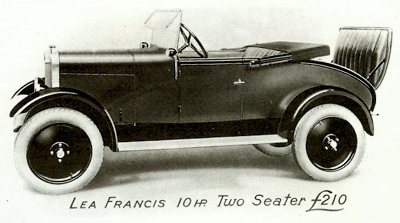 1926 Lea-Francis two-seater plus dickey 10hp.
1926 Lea-Francis two-seater plus dickey 10hp.
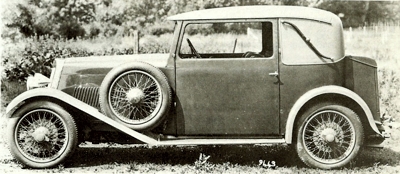 1930 Lea-Francis 12/40hp with Weymann body. It was fitted with a 1496cc Meadows engine.
1930 Lea-Francis 12/40hp with Weymann body. It was fitted with a 1496cc Meadows engine.
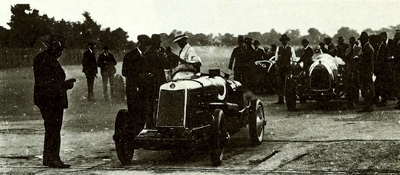 Ebby Ebblewhite flags off an S-type Lea-Francis at the Surbiton Club's meeting at Brooklands on 1st September, 1928.
Ebby Ebblewhite flags off an S-type Lea-Francis at the Surbiton Club's meeting at Brooklands on 1st September, 1928.
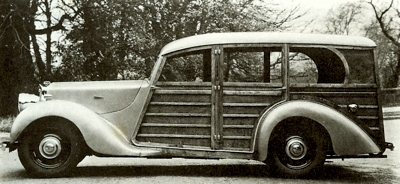 1946 14hp Lea-Francis Station Wagon.
1946 14hp Lea-Francis Station Wagon.
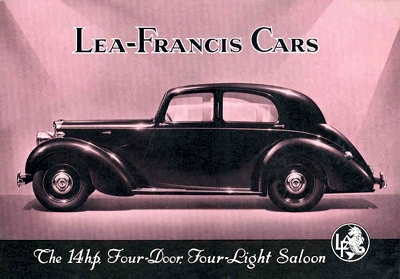 Lea Francis 14hp four door light saloon.
Lea Francis 14hp four door light saloon.
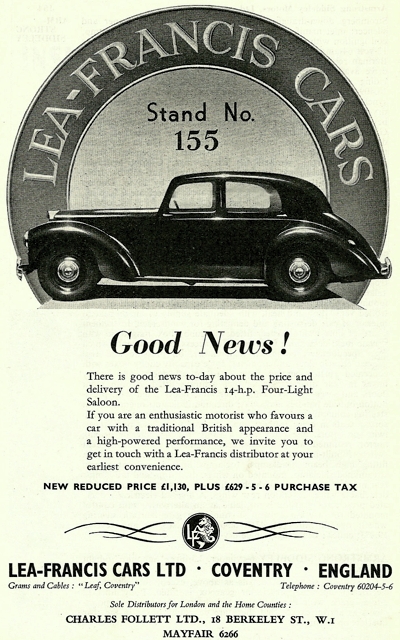 Lea-Francis Four-Light Saloon.
Lea-Francis Four-Light Saloon.
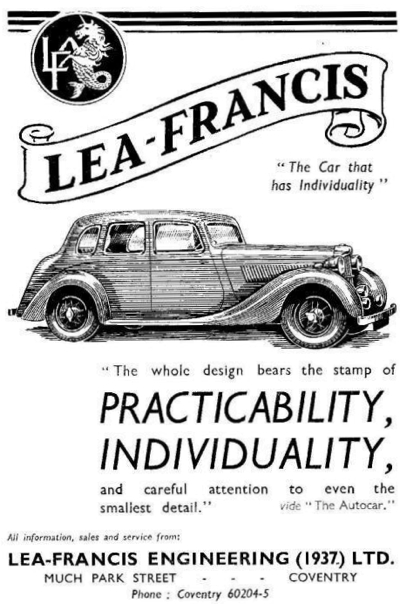 1941 Lea-Francis.
1941 Lea-Francis.
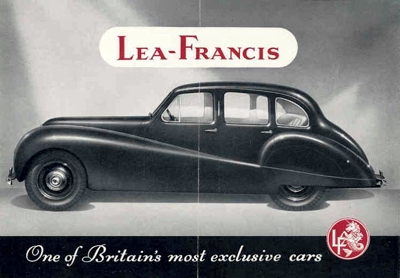 1951 Lea Francis.
1951 Lea Francis.
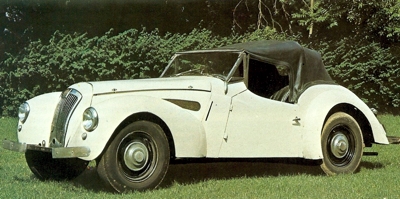 1955 Lea-Francis Cabriolet, powered by a four-cylinder 2½ liter engine.
1955 Lea-Francis Cabriolet, powered by a four-cylinder 2½ liter engine. |
At the time there were cautionary models in the range, even to some which were devoid of the now popular front-wheel brakes. It may have been the 1924 RAC Six Days Small Car Trials, centred on Llandrindod Wells in Wales, which put Lea-Francis firmly in the limelight. This was a strenuous event, consisting of alternate loops of mountain roads and unmade lanes, with a finale at Brooklands.
Bwlch-y-Groes Wizard
Official observers riding in the cars deducted marks for all involuntary stops and hill-climbing; fuel and oil consumption, the need to adjust brakes, and so on, were carefully checked. In the Trial a Ten with 'Chummy' body did extremely well and was paid the compliment of having the name 'Bwlch-y-Groes Wizard' written on its mud-covered body by fellow competitors, this being the worst gradient they had had to attempt during the week's motoring.
Such a model was listed by 1927. Thus the sporting world had its attention drawn to how superior the quality of Lea-Francis was compared to the'many indifferent small cars on sale at this time. F. L. M. Harris, when he was editor of The Light Car and Cyclecar, put the 1½-liter ohv Meadows engine into a 'Chummy' Ten Lea-Francis, an excellent example of the special-builders' recipe of installing a big engine in a light vehicle.
It may have been this which encouraged the company to advance to the use of this fine engine in the 12/20 and 12/40 models. The Meadows Company, which made engines for marine and stationary purposes as well as supplying the Motor Industry, was building the 69 x 100 mm 1496 cc push-rod four-cylinder power unit which, more by chance than design, proved easy to tune or hot-up. It was the mainstay of the 'Chain Gang' Frazer Nash cars after they had outgrown the side-valve Anzani engine, and it was to do equal good for Lea Francis.
The Hot Lea Francis 12/40 Sports
It was a straightforward, not too heavy, engine and, after some alterations to the cylinder head (the Deflector head), this 4ED model was able to produce at least 50 bhp, at a modest 4200 rpm. Moreover, it would withstand supercharging. The 12 hp models got into production by mid-1925 but prior to this a specially hotted-up 12/40 sports model had been prepared, with a guaranteed speed of 60 mph and those handsome lines which, in conjunction with a distinctive radiator shape, were to characterise the make from then on.
Although the cars were assembled products, somehow Lea-Francis contrived - to use proprietory components without this being unduly apparent or it having an adverse effect on the appeal of their cars. The company was now all set for considerable success. They had evolved their own front-wheel brakes for the sports 12/40, and these faster models had centre-lock wire wheels.
The non-sporting cars still had disc wheels, and a de-tuned ED Meadows engine was installed in the 12/22 cars, with cast-iron pistons. But it is the eyeable two-tone finished sports 12/40 and 12/50 models by which Lea-Francis is best remembered in the vintage context. All their associations with the Vulcan Company were not as beneficial as the introduction to the use of Meadows engines.
For example, in 1926 Lea-Francis were persuaded to go for the advancing cult of the six-cylinder car. They did this by letting Vulcan design, and build for them at Southport, a twin-carburetor, 2.2-Iitre push-rod ohv six with cantilever rear suspension and overhead-worm final drive. It was given a sporting-looking body and the intention was to sell it for £525.
It was a project that misfired financially. No doubt this did not notably trouble the Coventry personnel, because they had a very good range of cars to put into their 1927 catalogue. Apart from the afore-mentioned 10 hp 'Bwelch Wizard' and the rest of the three-speed Tens, the 12/22 and 12/40 models were a vailable in a variety of body styles and with complete equipment.
The Super Sports versions were now all guaranteed to do 70 mph and were good-lookers, even to imitation ship's ventilators on the scuttles. All was set for a profitable season for the small Coventry firm but, alas, they refused to let their flirtation with a six-cylinder product be forgotten. They now introduced an A. O. Lord-designed 1.7-liter six which, on the drawing board, appeared to be it most encouraging offering, as it had twin overhead camshafts, driven by chain, and a machined and balanced crankshaft.
But when built it proved a failure, having unfortunately low sets of gear ratios and a dire habit of running its big-ends. These six-cylinder Lea-Francis tourers were run at Brooklands in the summer of 1927, and the complicated engine proved a failure. Fortunately, to mitigate the losses sustained by playing about with this unsuccessful six-cylinder car, the company was now embarking on a proper racing programme.
The Lea Francis Hyper Sports 12/50
Lea Francis were encouraged to do this because of the potency of the 'Hyper' sports model. This was a 12/50 chassis using the 4ED Meadows engine to the best possible advantage. A French Cozette vane-type compressor or supercharger further boosted the power output, and the car carried a proper two-seater sports body and was distinguishable by its backwards-inclined radiator, also used for some other sporting models.
At the time, supercharging was seen as a useful means of quickening up production sports cars. Lea-Francis did it well. They stripped down each Meadows engine as it arrived from Wolverhampton, lowering the compression-ratio to suit the higher compression pressures entailed by forced induction, put in a needle-roller-bearing crankshaft and steel con-rods, and generally made the power unit suitable for sustained high-speed driving.
The 1928 RAC Tourist Trophy
Those who found Bugattis, Alfa Romeos and Maseratis too expensive to buy and maintain were enthralled by the British attempt to fill the gap during the later vintage period. Moreover, Lea-Francis demonstrated the potency of the 'Hyper' in important racing events. The most publicised victory came in the 1928 RAC Tourist Trophy race for production-type sports cars, run over the ordinary Irish roads at Ards, near Belfast.
This race, run under a complicated handicap, was the first of the new series of TT races and attracted an enormous and very varied entry. It promised untold excitement and consequently brought along a very big crowd of keen spectators and received considerable Press coverage. In the midst of all this, Kaye Don, driving an Avon-tyred supercharged 'Hyper' Lea-Francis, pulled off first place, at 64.06 mph. Very close behind came Cushman's front-wheel-drive four-cylinder Alvis, another British sports car of interest to the buying public.
But Lea-Francis had been declared the outright winner, taking the great Daily Mail Trophy, and they also won the important 1½-liter class, for which The Motor had donated a trophy. George Eyston's Lea-Francis had come home sixth, at 61.14mph in this 410-mile race, behind larger cars (apart from the Alvis), a performance not lost on the more observant onlookers.
The race rules, moreover, had ensured that the competing cars were quite close to catalogue specification. The victorious 'Hyper' Lea-Francis had a strengthened back axle, vacuum-serve brakes and 50-gallon fuel tank in the tail of the body. Apart from some lubrication problems with the supercharger these were reliable sports cars, with very good performance for their engine capacity.
The 1928 ICC 200 Mile Race
Top speed was in the region of 90 mph and the price could only be regarded as modest, at £495 as supplied 'over the counter'. There was a 'Hyper' coupe able to do nearly 85 mph and an 'Ulster' 12/40 saloon, among the delectable Lea-Francis models of the time. Further racing success helped sales. Special cars were run at Brooklands: Kaye Don in a stripped sports Lea-Francis was beaten only by out-and-out racing cars in the 1928 ICC 200 Mile Race at the Track, finishing in third place at an average speed of almost 69 mph.
In the following season, 1929, although an entry of no fewer than eight cars in the Ulster TT availed the make very little, it put up a great showing in the Irish Phoenix Park races, 'Hyper' cars being placed second, third and fourth in the Saorstat Cup division, driven respectively by Sammy Davis, Green and Shaw. Against this, none of the alloy-bodied 'Hypers' finished in that 1929 TT, Kaye Don's car breaking a piston. But it must be remembered that not only were weather conditions appalling, but the Alvis rivals were now straight-eights and that the 1½-liter class now included the works Alfa-Romeo entry, although it was Caracciola's enormous Mercedes-Benz which defeated one of these Italian cars
However, the speed allied to stamina of the 1927/8 type 'Hyper' Lea-Francis was shown in the closing long-distance race of 1929, the BRDC 500 Mile marathon at Brooklands, when one of the same-as-you-can-buy sports models was placed seventh, and first in the 1500cc class, at a pace of just less than 90 mph. The future thus looked rosy for the firm in Lower Ford Street, even if they would persist with the 14/40 2-Iitre six-cylinder.
For 1930, the range consisted of the U-series 12/22 hp cars, a P-type 12/40 with upright radiator, the sloping radiator, closed-bodied V and W models, and the S-type 'Hyper'. It was a fine selection of sturdily-made, nice-looking, sensible motor cars, that had amply proved their merit in the field of racing. At Le Mans that year Peacock and Newsome drove a 'Hyper' from the factory in the Rudge Whitworth Cup and brought it in fourth, and sixth overall, although the race rules made it necessary to carry a four-seater body.
The Lea Francis Ace of Spades
Not only was the Lea-Francis firmly a favorite in the 1½-liter class, but at long last the factory had settled for an effective six-cylinder car. This was the rare 'Ace of Spades', so called because it had a single-overhead-camshaft 2-liter power unit which, seen from certain aspects, resembled this card in the pack. This time the Coventry engineers had done the designing. This improved six-cylinder was intended for the 1931 season but was shown at the Motor Show of 1930.
The chassis used was not all that different from the popular Lea-Francis 12/22 model but a new four-speed gearbox had been prepared for it, which had constant-mesh third and fourth speeds, and so was known as the 'Duo' gearbox. This was quiet where the other Lea-Francis models made themselves heard when in the indirect ratios and altogether, with its six-windowed saloon body, safety glass and chromium plating for which were standard, and the older-fashioned feature of a right-hand gear lever, this 'Ace of Spades' promised to swell the Lea-Francis coffers.
Charles Turner appointed Receiver
It had a 4.7 to 1 top gear, and in this a speed of just less than the claimed 75 mph could be achieved. The silent third gear was good for about 60 mph if the single ohc engine was fully used, and this superior brother to the well-established four-cylinder models was to sell at £495. Unfortunately it came into the picture rather too late. Design might be encouraging but finances were not and by November of 1930 a Receiver had been appointed, in the guise of Charles Turner. Sometimes, Receivers pull stricken companies through. Turner managed to keep production of the Lea-Francis going until the end of 1935 or there-abouts but only in microscopic numbers, while it is doubtful whether more than a handful of cars were delivered.
In 1934, the prices of the old 12/40 and of the six-cylinder had dropped, but the quantity of work in the Coventry premises was not encouraging. Fortunately for those who liked Lea-Francis cars, all was not yet at an end. In 1937, G. H. Leek and R. H. Rose got together to form a fresh company, Lea-Francis Engineering (1937) Limited, moving out of the old premises into a former Triumph plant in Much Park Street, still in Coventry. Hugh Rose had designed many engines in his time, not least the inclined-valve Riley unit for Victor Riley, using two camshafts in the base chamber and short pushrods, to avoid the complexity of twin-overhead-cam gear.
The Lea-Francis 12 and 14
He used a similar layout for the resuscitated Lea-Francis, which was made in two sizes, a 72 x 100 mm Fourteen and a 69 x 100 mm Twelve. This launched the make on a new lease of life, especially as, apart from these luxurious saloons, priced from £395, the traditional sports model was also made, listed at £475. This had a specially tuned version of the It-liter engine and a more appropriate back-axle ratio, and Charles Follett, the Alvis exponent, who was the London Lea-Francis agent, raced a stripped version at Brooklands.
With the outbreak of World War 2 Lea-Francis were once again in the doldrums. However, many believe it was not as a result of the war, but rather the crippling purchase-tax, which killed off this promising re-start. After a struggle to keep the basic price down to below £1000, it had to be increased and customers for the heavier post-war cars dwindled, because then the vicious tax applied, making the cars a too-expensive proposition.
The Bubble Car and the Francesca
Even at this late date the company soldiered on. They brought out a sports model in 1947 which gave 64 bhp to the saloon's 56, and in 1950 this was replaced by a 2½-liter which produced 87 bhp. Making much of their own bodywork, the rising costs of materials and labour began to tell, and not even an Export Fourteen and the bigger Eighteens could fend off disaster. Lea-Francis were not at the Show in 1953. They closed their Service Station in Coventry in 1958. New management tried the breath-of-life in 1960 with the Ford Zephyr-powered Leaf-Lynx roadster, an ugly car costing an pricely £2000. After some efforts with a bubble-car and the still-born 'Francesca', a great name in the British motoring field was no more.
